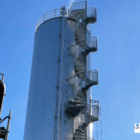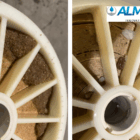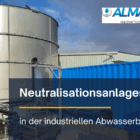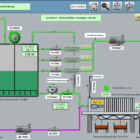A butterfly valve is an important component in industrial water and wastewater technology that is used to regulate, control and shut off pipelines. It belongs to the category of shut-off valves and is used in particular when reliable and fast opening or closing of pipelines is required. The butterfly valve is ideally suited for use in industrial circuits such as water treatment, waste water treatment and cooling water systems due to its simple design, small footprint and high flow capacity.
Table of contents
Technical background
The butterfly valve usually consists of a round disk (also known as a butterfly disc) that is rotatably installed in a housing. This disk can be rotated by 90 degrees to either open or close the flow completely. Unlike gate valves or ball valves, where the flow is interrupted linearly, the butterfly valve works via a rotating movement of the disc.
Depending on the application and the requirements for material resistance, flow rate and operating pressure, butterfly valves are available in various designs. Common materials for the valve disc and seals are stainless steel, cast iron, plastics or rubber linings, which are selected depending on the medium and operating conditions.
Structure and mode of operation
Body: The body of a butterfly valve encloses the pipeline and holds the disc in position. It is designed to withstand high pressures and corrosive media. Corrosion-resistant materials such as stainless steel or coated cast iron are often used in industrial water treatment.
Butterfly disc: The disc of the butterfly valve is located in the center of the housing and can either open or completely close the flow opening by turning it 90 degrees. In the half-open state, the disk enables partial flow control, which also makes the butterfly valve suitable for throttling processes.
Actuation: The valve disc is usually controlled via a hand lever, gear drive, pneumatic or electric drive. The actuator depends on the requirements of the system and the accessibility of the butterfly valve. In fully automated systems, such as in water treatment and wastewater treatment plants, butterfly valves are often controlled remotely via electric or pneumatic actuators in order to optimize the operation of the system.
Types of butterfly valves
Centric butterfly valve: The centric butterfly valve is the simplest and most frequently used design. Here, the valve disc is located in the middle of the body and the shaft is also arranged centrally. This design is cost-effective and is particularly suitable for low-pressure applications or media with low to medium viscosity.
Eccentric butterfly valve: The eccentric butterfly valve has a slightly offset shaft arrangement, which results in a better seal when closing. This design is often used for higher pressures or abrasive media, as it enables a higher sealing force.
Double eccentric butterfly valve (double flanged butterfly valve): This butterfly valve is designed for more demanding applications where both high operating pressure and tight shut-off are required. The double eccentricity of the shaft minimizes wear on the seals, resulting in a longer service life.
Triple eccentric butterfly valve: This butterfly valve has a triple eccentricity that enables a metallic seal at high temperatures and pressures. It is used in applications where extremely high demands are placed on tightness and temperature resistance, such as in steam systems or chemical processes.
Applications in practice
Butterfly valves are used in a variety of applications in industrial water and wastewater treatment:
Cooling water systems: Butterfly valves are used in cooling water systems to efficiently control large volumes of water. Due to their small footprint and fast switching times, they are ideal for interrupting or regulating the water flow as required.
Water treatment systems: In water treatment, butterfly valves are often used in filter systems, reverse osmosis systems (product overview of filter and reverse osmosis systems) or ion exchangers to control the water flow. They can be used here to regulate the flow or as an emergency shut-off to interrupt operation or enable maintenance work.
Wastewater treatment plants: In wastewater treatment plants, butterfly valves are an essential part of the piping systems used to control water and sludge flows. They are often used in precipitation and flocculation plants (such as our ALMA CHEM MCW) as well as in sedimentation tanks to regulate the flow of treated or untreated wastewater.
Chemical and industrial processes: Butterfly valves are used in chemical processes and for dosing chemicals in order to control aggressive media such as acids or alkalis. The choice of materials is crucial to prevent corrosion or wear.
Advantages of the butterfly valve
- Compact design: Butterfly valves require significantly less space compared to other valve types such as gate valves or ball valves and are therefore well suited for tight installation areas.
- Fast switching times: The flow rate can be regulated quickly and precisely thanks to the rotating valve disk.
- Low pressure loss: When the valve is fully open, the pressure loss is minimal, which makes it particularly attractive for applications with high flow rates.
- Easy maintenance: Butterfly valves are relatively low-maintenance and easy to inspect and maintain thanks to their simple design.
Challenges and limits
- Tightness: For low pressures and centric designs, tightness may be limited. Eccentric butterfly valves are more suitable for applications with high sealing requirements or aggressive media.
- Wear: In abrasive or corrosive environments, the seals and disc can wear out over time, which is why the choice of material is crucial.
Conclusion
The butterfly valve is a versatile and efficient solution for controlling and regulating water and wastewater flows in industrial plants. Their compact design, fast response time and low pressure loss make them a preferred choice in many areas of water technology and wastewater treatment. The right choice of materials and valve types is crucial for longevity and reliable operation in demanding environments.








